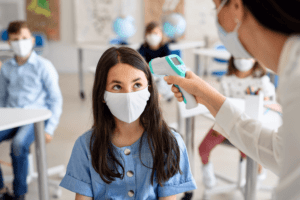8/23/21—In light of this summer’s surge in COVID-19 cases, and the growing prevalence of the Delta variant, the Occupational Safety and Health Administration (OSHA) has followed suit and updated their guidelines. Employers should educate themselves on the key changes and recommendations, to provide a safe workplace for employees who are vaccinated, unvaccinated, or otherwise at-risk due to health and disability.
Vaccine education and accessibility are vital to employee safety and workplace protection. Employers are advised to provide education about vaccine safety, as well as where employees can receive vaccines. Helpful resources for vaccine education and acquisition include your local health department or hospital and the Centers for Disease Control and Prevention (CDC) website. Providing paid time off (PTO) to facilitate employee vaccination and recovery is also encouraged. If your business is under 500 employees, you may be eligible for PTO assistance via tax credits from the American Rescue Plan.
Other safety measures involve a multi-layered approach within the workplace, which includes proper distancing, employer-provided personal protective equipment (PPE), contact tracing and proactive action in cases of infection. Employees should maintain a 6-foot distance whenever possible, utilize face coverings when indoors or heavily populated outdoor areas, and practice regular hand washing or sanitization throughout the day. If employees work in close quarters, such as on production lines or in animal processing plants, clear barriers can be put in place to further protect them from transmission.
Another key element to fighting transmission is limiting the amount of people in any area at any given time. To combat this, OSHA recommends instigating flexible worksites, such as remote work when possible. Creating flexible work hours by staggering shifts, and breaks too, also helps reduce the number of people in the workplace at any given time. Employees with disabilities, such as immuno-compromised, should be provided with extra measures as well. If they are unable to work remotely, consider creating a separate workspace for them onsite, with clear barriers and distanced from other workers.
In compliance with OSHA guidelines, employers are advised to contact trace in the workplace as well. This includes monitoring any employee interactions, and swift notification of close contacts whenever a COVID-19 case is detected. In the event an employee tests positive, said employee should be expected to quarantine at home for 14 days until a negative result is received. Close contacts should not return to work until negative for COVID-19 as well. Vaccinated employees identified as close contacts should be tested 3-5 days following exposure and should not return to work unless a negative result is shown. Unvaccinated close contacts should be tested 5-7 days after exposure. Should a close contact test positive, they will need to quarantine at home for 14 days as with other positive employee cases. Because of the need for quarantining, OSHA recommends ensuring that COVID-related absences are non-punitive.
It is also required that employers follow OSHA guidelines for notification to proper authorities. Employers must record cases of COVID-19 in the workplace using OSHA’s Form 300 logs if the case is work-related, and involves one or more relevant recording criteria. Employers must follow the requirements in OSHA’s 29 CFR part 1904 when reporting COVID-19 fatalities and hospitalizations to OSHA. AlertTrace makes reporting easier by doing all of the heavy lifting, capturing the data needed accurately and consolidating it in a user-friendly dashboard.
Although returning to work and providing a safe workplace for your employees may seem overwhelming, AlertTrace is here to help with our easy to utilize contact tracing system. Not only does AlertTrace accurately track contacts, ensuring infections are mitigated effectively, but it provides the highest level of privacy to your employees. AlertTrace never tracks location only contacts, and it protects employee privacy with anonymized data, as only administrators will have access to identification of employees when contact tracing is needed.
Contact us today to learn more about how AlertTrace can help ease the process of returning to work safely, keeping your business running smoothly.
…
“American Rescue Plan Tax Credits Available to Small Employers to Provide Paid Leave to Employees RECEIVING COVID-19 VACCINES; New Fact SHEET Outlines Details.” Internal Revenue Service, www.irs.gov/newsroom/american-rescue-plan-tax-credits-available-to-small-employers-to-provide-paid-leave-to-employees-receiving-covid-19-vaccines-new-fact-sheet-outlines-details.
“Case Investigation and Contact Tracing In Non-Healthcare Workplaces: Information for Employers.” Centers for Disease Control and Prevention, Centers for Disease Control and Prevention, www.cdc.gov/coronavirus/2019-ncov/community/contact-tracing-nonhealthcare-workplaces.html.
“Department of Labor Logo United Statesdepartment of Labor.” 1904.7 – General Recording Criteria. | Occupational Safety and Health Administration, www.osha.gov/laws-regs/regulations/standardnumber/1904/1904.7.
“Department of Labor Logo United Statesdepartment of Labor.” Occupational Safety and Health Administration, www.osha.gov/news/newsreleases/trade/08132021.
“Department of Labor Logo United Statesdepartment of Labor.” Protecting Workers: Guidance on Mitigating and Preventing the Spread of COVID-19 in the Workplace | Occupational Safety and Health Administration, www.osha.gov/coronavirus/safework.
“Department of Labor Logo United Statesdepartment of Labor.” Revised Enforcement Guidance for Recording Cases of Coronavirus Disease 2019 (COVID-19) | Occupational Safety and Health Administration, www.osha.gov/laws-regs/standardinterpretations/2020-05-19.




